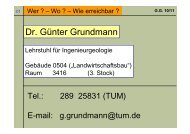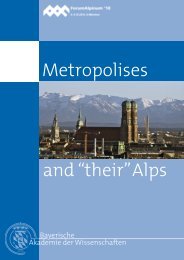The 1806 Goldau landslide event—analysis of a large rock slide
The 1806 Goldau landslide event—analysis of a large rock slide
The 1806 Goldau landslide event—analysis of a large rock slide
Create successful ePaper yourself
Turn your PDF publications into a flip-book with our unique Google optimized e-Paper software.
1807, Blatzer 1875, Riedl 1877, Ott 1905, 1920, Heim 1932, Kopp 1936, Lehmann 1942) as<br />
well as artists like W. Turner, H. Keller or D.A. Schmid concentrated on the natural disaster<br />
and it’s appearance (Bollinger 2006).<br />
2 CHARACTERIZATION OF THE ROSSBERG SLIDE<br />
Since Heim 1932, Kopp 1936 and Lehmann 1942, no modern analysis has been undertaken.<br />
In 2003, the whole <strong>land<strong>slide</strong></strong> area has been mapped in detail (Berner 2004) and the event and<br />
its causes and processes have been refurbished since then (Thuro et al. 2006a, b, c, Bollinger<br />
2006). Besides hazard mapping, the intention was to establish a constitutional model <strong>of</strong> the<br />
failure mechanism and to set up a numerical model <strong>of</strong> the failure process. Albert Heim (1932)<br />
presented the most accepted scientific approach in his monograph “Bergsturz und Menschenleben”<br />
(<strong>land<strong>slide</strong></strong>s and human life). But further research once more uncovers some discrepancies<br />
to the view given by him. In this paper, some results will be highlighted in this respect.<br />
2.1 Geological setting<br />
<strong>The</strong> <strong>land<strong>slide</strong></strong> area is situated about 50 km south <strong>of</strong> Zurich in the Canton <strong>of</strong> Schwyz, at the<br />
tectonic border between the Molasse basin and the Helvetic napes <strong>of</strong> the Alps (Figure 1).<br />
<strong>The</strong> village <strong>of</strong> <strong>Goldau</strong> is situated between the lake <strong>of</strong> Zug and the lake <strong>of</strong> Lauerz (Figure 2),<br />
the <strong>Goldau</strong> <strong>rock</strong> <strong>slide</strong> is indicated with blue dots below the Rossberg. <strong>The</strong> bedding planes are<br />
generally dipping south. <strong>The</strong> Rossberg massive as well as the Rigi on the other side <strong>of</strong> the<br />
valley is composed <strong>of</strong> abundant conglomerates interbedded with clayey marlstones and sandstones<br />
<strong>of</strong> the Lower Freshwater Molasse (age about 24 my, upper Oligocene/lower Miocene;<br />
Heim 1932, Vogel & Handtke 1988, Handtke 2006).<br />
<strong>The</strong> sedimentological environment <strong>of</strong> these deposits is an alluvial fan with coarse channel<br />
fills and debris flows as well as fine slack water and flood plain deposits. This explains the<br />
interstratifications <strong>of</strong> the various grain sizes from fines over sand to gravel deposits at a small<br />
scale. <strong>The</strong> marlstones turn out to be clay-siltstones with considerably high calcite content <strong>of</strong><br />
up to 40% when fresh. <strong>The</strong> thickness <strong>of</strong> the conglomerate layers varies from several meters<br />
up to 20 m typically (Figure 3 left) but may exceed up to 80 m without interception <strong>of</strong> any<br />
marlstone layer. <strong>The</strong>se extremely thick and coarse conglomerate beds originate from <strong>large</strong><br />
Figure 1. Geological overview <strong>of</strong> Switzerland with study area (red frame). Molasse basin in yellow,<br />
Helvetic napes in green colors.<br />
3694















